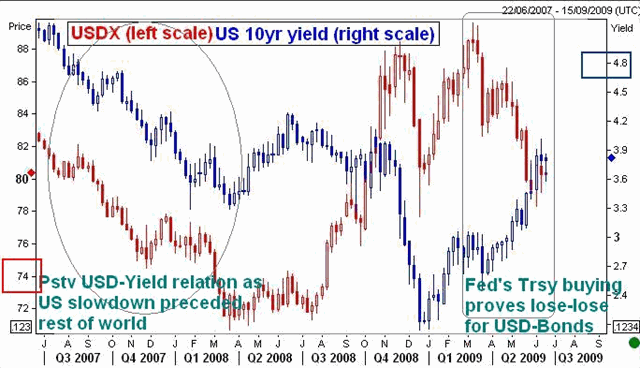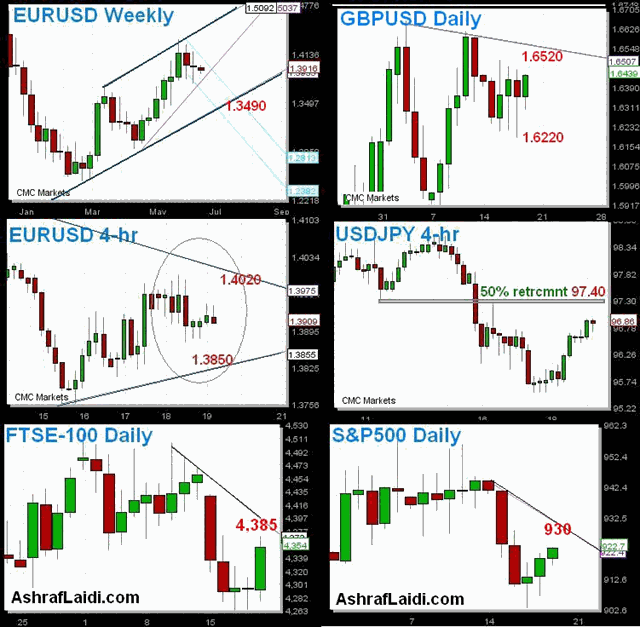Quantitative Easing Impact on U.S. Dollar and Treasury Bonds
InvestorEducation / US Bonds Jun 20, 2009 - 01:33 AM GMTBy: Ashraf_Laidi
 Neither the Fed, the Bank of England or the Bank of Canada can or plan to exit their quantitative easing policies any time soon.
Neither the Fed, the Bank of England or the Bank of Canada can or plan to exit their quantitative easing policies any time soon.
Thursday's recovery in European & US bond yields is a stark reminder of the continued undoing of the 29-year bull market in bonds and the ensuing recovery in long term rates, whose dampening effect on equities is proving increasingly evident. The pullback in equities has helped cap down bond yields earlier in the week, especially as the US bond-issuing schedule took a break this week. But as the US Treasury sets to finance this years 300% increase in the deficit (from last year) and the inflationary tide of the Fed's injection reaches ashore, the upward run in yields could complete the retracement process of its 20-year downtrend.
Just as BoE Gov King cautioned today against expecting a rapid recovery (a way of tempering premature expectations of an exit strategy of current quantitative easing), Wednesday's FOMC announcement and Thursdays testimony by Fed Chairman Bernanke will contain similar reminders intended at containing the rapid backup in yields. If successful, the Fed would be spared its weekly shopping sprees of U.S. treasury purchases, which remain about 6 times less the amount sold by the US Treasury.
Two Tries for Bernanke: Equities risk extending their recent pullbacks in the event that (i) the FOMC statement makes no mention of additional bond purchases, (ii) expresses no verbal (or projected) improvement in GDP growth. Any excessive backup in bond yields on Wednesday could force Bernanke to revisit asset purchases the next day at his Congressional testimony. The FOMC statement will aim at primarily staving off expectations of a near-term hike in interest rates via reiterating its forecast for benign inflation. The inflation element of the statement will be used to temper any potential yield bounce resulting from a likely upward revision in the Feds central tendency forecasts.

Any sign the Fed will veer away from its asset-purchasing schedule could add momentum to the dollars corrective bounce. This would be especially encouraged by any prolonged aversion to risk appetite, June FOMC meetings have been largely important as they not only precede a 6-7 week FOMC meeting hiatus but also aim at clarifying the Fed's latest central tendency projections on GDP growth, unemployment rate and Personal Consumption Expenditure price. But as the above chart shows, the unfolding (downward) re-coupling between yields and the dollar manifests the Fed's efforts to cap down yields, which are insufficient to offset the avalanche of new borrowing hence keep yields higherbut sufficient in inflating interbank liquidity and increasing the supply of dollars.
Below are the short-term technical parameters for the latest bounce in appetite before aversion sets in anew ahead of the FOMC meeting.

By Ashraf Laidi
AshrafLaidi.com
Ashraf Laidi is the Chief FX Analyst at CMC Markets NA. This publication is intended to be used for information purposes only and does not constitute investment advice. CMC Markets (US) LLC is registered as a Futures Commission Merchant with the Commodity Futures Trading Commission and is a member of the National Futures Association.
Ashraf Laidi Archive |
© 2005-2022 http://www.MarketOracle.co.uk - The Market Oracle is a FREE Daily Financial Markets Analysis & Forecasting online publication.



